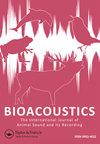Local competitive environment and male condition influence within-bout calling patterns in túngara frogs
IF 2.1
4区 生物学
Q2 ZOOLOGY
Bioacoustics-The International Journal of Animal Sound and Its Recording
Pub Date : 2022-05-10
DOI:10.1080/09524622.2022.2070544
引用次数: 1
Abstract
ABSTRACT Flexible signalling behaviour is widespread, with adjustments often enhancing gains or reducing costs of signalling based on the current state of the signaller’s local communication network. Male túngara frogs call within multispecies communication networks containing conspecifics (both target receivers and rivals) and eavesdropping predators. These diverse players all exert an influence on male calling strategies. We investigated the degree to which patterns of changes in call characteristics across individual túngara frog calling bouts were influenced by callers’ social environment, body condition, and ambient temperature. Most call bouts exhibited two distinct phases, an initial steep increase in call amplitude (the rise) followed by a longer period of more gradual amplitude increase (the plateau). Rises were completed more quickly when males called in denser choruses, while call amplitude increases during plateau phases were greater for males in better body condition. Males also produced more complex calls and increased complexity sooner when calling in denser choruses. Our results suggest that the social environment is the main driver of within-bout calling patterns. This could be due to (i) increased call effort required when competing in denser choruses, (ii) dilution effects provided by nearby rivals releasing callers from eavesdropping risk or, likely, (iii) a combination of both.当地竞争环境和雄性条件对吴哥蛙鸣叫模式的影响
摘要灵活的信令行为非常普遍,通常会根据信号员本地通信网络的当前状态进行调整,以提高信令的增益或降低信令的成本。雄性túngara蛙在包含同种(目标接收者和竞争对手)和窃听捕食者的多物种通信网络中呼叫。这些不同的参与者都对男性呼叫策略产生了影响。我们调查了个体túngara蛙叫声特征的变化模式在多大程度上受到呼叫者的社会环境、身体状况和环境温度的影响。大多数呼叫发作表现出两个不同的阶段,呼叫振幅最初急剧增加(上升),然后是较长时间的振幅逐渐增加(平稳期)。当雄性发出更密集的合唱时,上升速度更快,而身体状况较好的雄性在高原期的叫声幅度增加幅度更大。雄性也会发出更复杂的叫声,在发出更密集的合唱时会更快地增加复杂性。我们的研究结果表明,社会环境是场内呼叫模式的主要驱动因素。这可能是由于(i)在密集的合唱中竞争时需要增加呼叫工作量,(ii)附近竞争对手提供的稀释效应使呼叫者免受窃听风险,或者(iii)两者的结合。
本文章由计算机程序翻译,如有差异,请以英文原文为准。
求助全文
约1分钟内获得全文
求助全文
来源期刊
CiteScore
4.50
自引率
0.00%
发文量
25
审稿时长
>12 weeks
期刊介绍:
Bioacoustics primarily publishes high-quality original research papers and reviews on sound communication in birds, mammals, amphibians, reptiles, fish, insects and other invertebrates, including the following topics :
-Communication and related behaviour-
Sound production-
Hearing-
Ontogeny and learning-
Bioacoustics in taxonomy and systematics-
Impacts of noise-
Bioacoustics in environmental monitoring-
Identification techniques and applications-
Recording and analysis-
Equipment and techniques-
Ultrasound and infrasound-
Underwater sound-
Bioacoustical sound structures, patterns, variation and repertoires

 求助内容:
求助内容: 应助结果提醒方式:
应助结果提醒方式:


